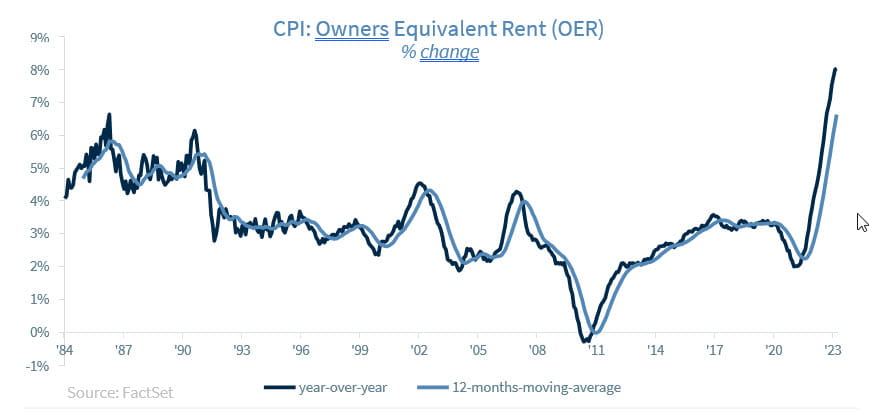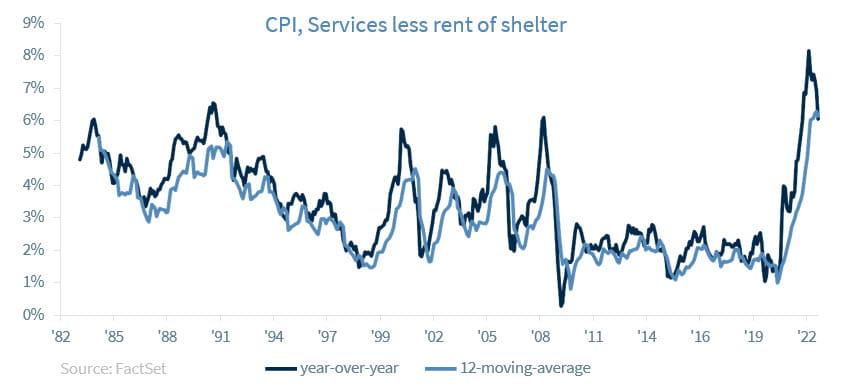by Eugenio J. Alemán, Chief Economist, Raymond James
Markets have been very positive this week on better-than-expected inflation numbers. The Consumer Price Index (CPI) printed a better than expected 0.1% in March with the year-over-year rate declining to 5.0% compared to a 6.0% year-over-year rate reported in February of this year. Meanwhile, the Producer Price Index (PPI) declined by 0.5%, the largest month-over-month decline since April of 2020. On a year earlier basis, the PPI was the lowest since January of 2021.
But the devil is in the details, although the details seem to have been sidestepped by markets earlier this week. And the details seem to indicate that although the fight against inflation continues, the road ahead is still perilous, especially considering the recent increase in petroleum prices and thus, in gasoline prices. But oil and gasoline prices are not the only reasons why we are not as happy as markets are today. Two of the most important sectors the Federal Reserve (Fed) is watching for inflation going forward are still way up there and although there are signs of weakening, there is still a long way to go before they make a substantial contribution to the disinflationary trend we are already seeing in other sectors.
We are talking about shelter costs but more specifically about owners’ equivalent rent. In March of this year, shelter costs increased 0.6% compared to 0.8% in February while owners’ equivalent rent increased 0.5% after an increase of 0.7% in February. For shelter costs it matched the increase we saw in November of last year while for owners’ equivalent rate it was the lowest reading since a similar print in April of 2022. However, the details are less encouraging, especially because shelter costs, which includes owners’ equivalent rent are still increasing on a year earlier basis as well as on a 12-month moving average basis.
The year-over-year owners’ equivalent rent was up 8.04% in March of this year, up from a print of 8.01% year-over-year to February while the 12-month moving average, which is the number that affects consumers the most, went from 6.35% in February to 6.64% in March as we can observe in the graph below. Both rates are the highest they have been since this component of the Index was created back in 1984. Furthermore, as the graph also points out, the 12-month moving average hits the peak several months after the year-over- year rate hits its peak.
Furthermore, another CPI number the Fed is watching is CPI services less rent of shelter. That is, what they are looking at is what is happening with core services without including the costs of housing because the U.S. service sector is still relatively strong and is the sector that continues to add jobs at a very strong pace. On a month-over-month basis, the CPI services less rent of shelter was flat, the lowest reading since October of last year while the February increase was just 0.1%. This recent weakness in the CPI services less rent of shelter component has brought the year-over-year rate of change for that Index down considerably, from a high of 8.16% in September of 2022 to a rate of 6.05% in March of this year. Furthermore, this recent slowdown in the year-over-year rate is just now making an impact on the 12-month moving average rate, as it went from 6.29% in February of this year to 6.15% in March, as shown in the graph below.
The weakness in this component of CPI is probably very encouraging for the Fed because it is showing that the service sector is probably slowing down to a point that it will continue to contribute to lower inflation in the next several quarters. This should be good news for the Fed and for the markets. However, acknowledging this is not the same thing as declaring victory in the fight against inflation.
Inflation targeting and the Fed
Inflation targeting, which is what the Fed strategy is for the U.S. means, according to its own view, that: “following periods when inflation has been running persistently below 2 percent, appropriate monetary policy will likely aim to achieve inflation modestly above 2 percent for some time. By seeking inflation that averages 2 percent over time, the FOMC will help to ensure longer-run inflation expectations remain well anchored at 2 percent.”
In today’s environment this translates to “following periods when inflation has been running persistently above 2 percent, appropriate monetary policy will likely aim to achieve inflation modestly below 2 percent for some time. By seeking inflation that averages 2 percent over time, the FOMC will help to ensure longer- run inflation expectations remain well anchored at 2 percent.”
This means that the Fed will need to conduct monetary policy consistent with achieving inflation below 2 percent for some time, which in today’s environment will not happen until after 2024 according to our own forecast.
Thus, expect high(er) interest rates for longer, see our “Thoughts of the Week” for March 31, 2023 for further discussion.
Economic and market conditions are subject to change.
Opinions are those of Investment Strategy and not necessarily those of Raymond James and are subject to change without notice. The information has been obtained from sources considered to be reliable, but we do not guarantee that the foregoing material is accurate or complete. There is no assurance any of the trends mentioned will continue or forecasts will occur. Last performance may not be indicative of future results.
Consumer Price Index is a measure of inflation compiled by the U.S. Bureau of Labor Statistics. Currencies investing is generally considered speculative because of the significant potential for investment loss. Their markets are likely to be volatile and there may be sharp price fluctuations even during periods when prices overall are rising.
Consumer Sentiment is a consumer confidence index published monthly by the University of Michigan. The index is normalized to have a value of 100 in the first quarter of 1966. Each month at least 500 telephone interviews are conducted of a contiguous United States sample.
Personal Consumption Expenditures Price Index (PCE): The PCE is a measure of the prices that people living in the United States, or those buying on their behalf, pay for goods and services. The change in the PCE price index is known for capturing inflation (or deflation) across a wide range of consumer expenses and reflecting changes in consumer behavior.
The Consumer Confidence Index (CCI) is a survey, administered by The Conference Board, that measures how optimistic or pessimistic consumers are regarding their expected financial situation. A value above 100 signals a boost in the consumers’ confidence towards the future economic situation, as a consequence of which they are less prone to save, and more inclined to consume. The opposite applies to values under 100.
Leading Economic Index: The Conference Board Leading Economic Index is an American economic leading indicator intended to forecast future economic activity. It is calculated by The Conference Board, a non- governmental organization, which determines the value of the index from the values of ten key variables
Certified Financial Planner Board of Standards Inc. owns the certification marks CFP®, Certified Financial Planner™, CFP® (with plaque design) and CFP® (with flame design) in the U.S., which it awards to individuals who successfully complete CFP Board's initial and ongoing certification requirements.
Links are being provided for information purposes only. Raymond James is not affiliated with and does not endorse, authorize or sponsor any of the listed websites or their respective sponsors. Raymond James is not responsible for the content of any website or the collection or use of information regarding any website's users and/or members.
GDP Price Index: A measure of inflation in the prices of goods and services produced in the United States. The gross domestic product price index includes the prices of U.S. goods and services exported to other countries. The prices that Americans pay for imports aren't part of this index.
FHFA House Price Index: The FHFA House Price Index is the nation’s only collection of public, freely available house price indexes that measure changes in single-family home values based on data from all 50 states and over 400 American cities that extend back to the mid-1970s.
Expectations Index: The Expectations Index is a component of the Consumer Confidence Index® (CCI), which is published each month by the Conference Board. The CCI reflects consumers' short-term—that is, six- month—outlook for, and sentiment about, the performance of the overall economy as it affects them.
Present Situation Index: The Present Situation Index is an indicator of consumer sentiment about current business and job market conditions. Combined with the Expectations Index, the Present Situation Index makes up the monthly Consumer Confidence Index.
Pending Home Sales Index: The Pending Home Sales Index (PHS), a leading indicator of housing activity, measures housing contract activity, and is based on signed real estate contracts for existing single-family homes, condos, and co-ops. Because a home goes under contract a month or two before it is sold, the Pending Home Sales Index generally leads Existing-Home Sales by a month or two.
DISCLOSURES
Import Price Index: The import price index measure price changes in goods or services purchased from abroad by
U.S. residents (imports) and sold to foreign buyers (exports). The indexes are updated once a month by the Bureau of Labor Statistics (BLS) International Price Program (IPP).
ISM New Orders Index: ISM New Order Index shows the number of new orders from customers of manufacturing firms reported by survey respondents compared to the previous month.ISM Employment Index: The ISM Manufacturing Employment Index is a component of the Manufacturing Purchasing Managers Index and reflects employment changes from industrial companies.
ISM Inventories Index: The ISM manufacturing index is a composite index that gives equal weighting to new orders, production, employment, supplier deliveries, and inventories.
ISM Production Index: The ISM manufacturing index or PMI measures the change in production levels across the
U.S. economy from month to month.
ISM Services PMI Index: The Institute of Supply Management (ISM) Non-Manufacturing Purchasing Managers' Index (PMI) (also known as the ISM Services PMI) report on Business, a composite index is calculated as an indicator of the overall economic condition for the non-manufacturing sector.
Source: FactSet, data as of 12/29/2022

















